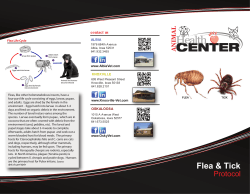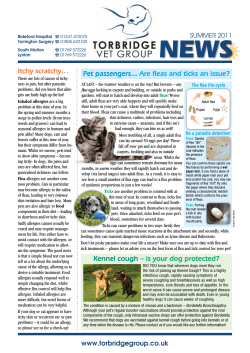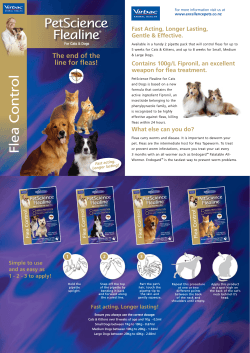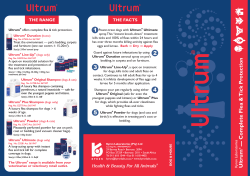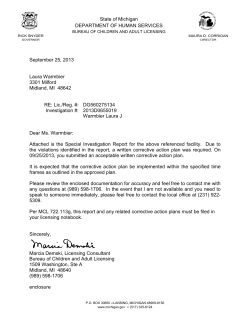
Fleas: What They Are, What To Do 1 Identification
ENY-291 Fleas: What They Are, What To Do 1 D. L. Richman and P. G. Koehler2 Identification There are over 2,000 described species of fleas in the world. The most common domestic flea is the cat flea (Ctenocephalides felis felis). The dog flea (Ctenocephalides canis) appears similar to the cat flea, but is rare in the United States. The sticktight flea (Echidnophaga gallinacea) can become a problem if pets frequent areas associated with poultry. Eggs are oval, and smooth (Figure 1). They are tiny (0.5mm), but visible to the naked eye. Their white color may prevent them from being seen on lightly colored fabric. Small wormlike larvae (1.5-5 mm in length) hatch from the eggs. They are also visible to the naked eye. They are eyeless, legless and sparsely covered with hairs (Figure 2). The larval body is translucent white with a dark colored gut that can be seen through the skin. These immature fleas will eventually spin silken cocoons in which they will develop (pupate) into adult fleas. Cocoons are sticky, attracting dirt and debris. This camouflage may prevent them from being seen. Adults are about 1-3 mm in length, reddish-brown to black, wingless, and laterally compressed (Figure 3). Their powerful hind legs are well adapted for jumping and running through hair and feathers. Figure 1. Flea egg. Figure 2. Flea laravae. Figure 3. Adult flea. 1. This document is ENY-291, one of a series of the Entomology and Nematology Department, Florida Cooperative Extension Service, Institute of Food and Agricultural Sciences, University of Florida. First published: March 1997. Revised: July 2007. Please visit the EDIS Website at http://edis.ifas.ufl.edu. 2. D. L. Richman, graduate assistant, and P. G. Koehler, professor, Department of Entomology and Nematology, Cooperative Extension Service, Institute of Food and Agricultural Sciences, University of Florida, Gainesville, 32611. The Institute of Food and Agricultural Sciences (IFAS) is an Equal Opportunity Institution authorized to provide research, educational information and other services only to individuals and institutions that function with non-discrimination with respect to race, creed, color, religion, age, disability, sex, sexual orientation, marital status, national origin, political opinions or affiliations. U.S. Department of Agriculture, Cooperative Extension Service, University of Florida, IFAS, Florida A. & M. University Cooperative Extension Program, and Boards of County Commissioners Cooperating. Larry Arrington, Dean Fleas: What They Are, What To Do Life Cycle & Biology Cat flea adults, unlike many other fleas, remain on their host. Females require a fresh blood meal in order to produce eggs, and they can lay up to 1 per hour! The smooth eggs easily fall from the pet onto the carpet, bedding, or lawn. Adult fecal matter consists of relatively undigested blood. This dried blood also falls from the pet and serves as food for the newly hatched larvae. The young fleas will hatch within 2 days and feed on dandruff, grain particles, and skin flakes found on the floor around them, in addition to the fecal matter provided by adult fleas. They prefer to develop in areas protected from rainfall, irrigation, and sunlight, where the relative humidity is at least 75% and the temperature is 70-90°F. The larval stage lasts 5-15 days (Figure 4). 2 flea allergy dermatitis, lasting up to 5 days and characterized by intense itching, reddening at the bite site, hair loss, and secondary infection. Cat fleas also serve as intermediate hosts of the dog tapeworm (Dipylidium caninum). This intestinal parasite is transmitted to the pet while grooming via ingestion of an adult flea carrying a tapeworm cyst. The flea is infected by ingestion of the cyst during its larval stage. The parasite segments resemble small pieces of rice and may be discovered around the anal region of your pet. Philosophy of Flea Control Effective control requires eradication of fleas from the pet, the home, the yard, and control of the flea life cycle. Removal of fleas from the pet alone is futile; immature fleas (eggs, larvae, pupae) develop off the pet and new adults simply jump on, causing subsequent reinfestation. New and safe products are available that can be used as part of a reduced chemical control program. There are also ways of making the environment less suitable for flea development. Flea control is a three part process: Figure 4. Flea life cycle. 1. Treat the Pet: Larvae spin silken cocoons within carpet fibers, floor crevices, or protected outdoor areas in which they will develop (pupate) into adult fleas. The cocoons are sticky and easily camouflaged by local debris. Under optimal conditions, new adults are ready to emerge within 2 weeks. They develop faster at higher temperatures, but can remain in their cocoons up to 12 months. Vibrations and/or an increase in carbon dioxide stimulate adults to emerge. Adults live 4-25 days and are the only stage that lives on the pet and feeds on fresh blood. Problems Associated With Fleas The cat flea is capable of transmitting plague and murine typhus to humans, but reports of such are rare; its primary importance is its nuisance to humans and pets. They are not picky about their meals; any warm-blooded animal will do. Bites usually cause minor itching, but may be more irritating to those with sensitive skin. Some people and pets suffer from Removing fleas from pets may be done by a veterinarian, grooming parlor, or by the pet owner on the day of treatment, either before or while the premises are being treated. A flea comb may be used, but is not very effective for removing fleas; only 10-60% will be collected. Fleas should be dropped in soapy water and then discarded. This method is very time consuming, though, and most pet owners prefer to shampoo their pets. Shampooing your pet removes the dried blood and skin flakes that fall to the ground and serve as food for flea larvae. The animal's body must be thoroughly lathered, and it is recommended that the lather remain for up to 15 minutes before the pet is rinsed. Flea shampoos contain various insecticides: Pyrethrins are derived from the chrysanthemum plant and kill fleas on the animal quickly. Pyrethroids are synthetically derived from pyrethrins and have better Fleas: What They Are, What To Do residual action. Both of these are usually enhanced with piperonyl butoxide, a compound which will inhibit the fleas from metabolically changing the insecticide into nontoxic, excretable compounds. Carbamate insecticides are also available for use in shampoos. Citrus peel derivatives, such as D-limonene, are also added to shampoos and are fairly mild, making them excellent for use on puppies andkittens, as well as in households with infants. Some pets however, especially cats, may exhibit allergic reactions to this type of product. Pennyroyal oil, another natural product, is also available in shampoos. Pulegone, the active ingredient in this oil, has dose related toxicity to mammals and may induce lethargy, vomiting, diarrhea, nose bleeds, seizures, and, possibly, death due to liver failure. There is no antidote to pulegone poisoning . Label directions and cautions should be carefully followed when using this type of product. Mixing your own shampoo with pure oil is not recommended. The newest advances in topical flea control applications are imidacloprid (Advantage) or fipronil (Frontline). Both are available as spot-on oils which are applied to the shoulder area of the pet and distribute over the body within a few hours. They are non-toxic to mammals and kill almost all fleas on the pet within 24 hours of treatment. Dogs and cats treated with imidacloprid have approximately 95% control for 3 weeks and then 80% control the fourth week. Fipronil kills 98% of the fleas on dogs and cats for 4 weeks, and efficacy continues for up to 8 weeks on dogs, but drops down to 80% protection on cats by sixth week. Fipronil also kills ticks on the animal for up to one month. If your pet displays flea allergy dermatitis take note: approximately 90% of the fleas on pets treated with either product fed (bit the pet) before their death. These fleas were also able to produce viable eggs. This means that while these products help reduce the symptoms of flea allergy dermatitis by killing fleas and reducing the number of flea bites on the animal, there may still be some allergic reaction because fleas are able to bite before dying. This blood meal will also enable them to reproduce. Insect growth regulators (IGRs) and insect development inhibitors (IDIs) work by interfering with egg development and molting of adolescent 3 fleas. They control the flea life cycle but do not kill adult fleas. Methoprene (Precor) and pyriproxyfen (Nylar, Archer) are IGRs available for pet treatment in sprays and flea collars. Lufenuron (Program), an IDI, is orally administered to the pet. These products do not take immediate effect because they target flea eggs and larvae. Use of one of these products along with use of Advantage or Frontline will kill adults and prevent development of immature fleas. Scientific evidence regarding dietary supplementation with vitamin B, Brewer's yeast, or garlic suggest these methods are of little value. Ultrasonic flea collars have also been proposed for use to keep fleas off pets, but are completely ineffective. Insecticidal flea collars also are not very effective. 2. Treat the Home: Indoor treatment should be concentrated on areas frequented by your pets; this is where most of the eggs and larvae will be located. Vacuum the entire house and dispose of the vacuum bag immediately there will be developing fleas inside! Vacuuming will remove flea eggs and stimulate new adults to emerge from their cocoons, exposing them to any insecticide residue on the floor. Also, vacuuming may not pick up any larvae due to their ability to wrap around and hold on to carpet fibers. Steam cleaning carpets is even more effective than normal vacuuming and should be considered if infestation is severe. Wash pet's bedding and throw rugs. Sprays or foggers containing an insecticide and insect growth regulator should be applied according to label directions after vacuuming. Borate carpet treatment, applied either by the homeowner or a professional exterminator, works as intestinal poison upon ingestion by flea larvae. The powder is sprinkled and worked into the carpet. Overall risk of danger to pets and humans is unknown, but appears to be low. This treatment, however, is not recommended for homes with infants. Diatomaceous earth has also been used as a chafing agent to control larvae in carpets, but it contains silica which is known to cause lung disease in humans if inhaled in excessive quantity. Fleas: What They Are, What To Do Light traps placed around the home, especially where the pet frequents, may collect fleas upon emergence from their cocoons. Adult fleas have been noted to orient themselves toward light and jump when light is interrupted, as though the shadow signals passing of an unsuspecting host. Tests indicate they prefer yellow-green light (525nm) that remains on for 10 minutes and flashes off for 5 seconds. However, it is doubtful that this trap will attract fleas off your pet. Cedar chips and leaves from wax myrtles may have some repellent properties (some people swear by them!), but have not been scientifically proven. Restrict pet access from areas that are hard to treat, such as children's playrooms, crowded garages or work areas. 4 if label directions are carefully followed. In fact, just spraying the yard with water is enough to reduce flea populations! The nematode treatment is probably not needed. Restricting pet access from areas that are difficult to treat (e.g., beneath porches, inside crowded sheds) may also help flea control. Detection and Monitoring Detection is as simple as seeing fleas on your pet, noticing your pets scratching, or flea bites around your ankles. Perhaps there are small black pieces of dirt covering your pet's bedding, or perhaps you've noticed tapeworm segments near or on your pet. The black dirt is the adult flea feces left behind to serve as food for larvae, and tapeworms are transmitted by ingestion of fleas. 3. Treat the Yard: Flea larvae develop in shaded, humid areas, but will drown in a flooded environment. Rainfall is often enough to curb larval development outdoors. In addition to drowning, the fecal dried blood meal provided by adult fleas is no longer available if the lawn is wet. Loose debris and weeds should be removed and the lawn mowed to expose their environment. Sprays containing insecticides registered for outdoor use, such as pyrethroids, may be applied during dry seasons every 2-3 weeks to shaded areas where pets frequent. Insect growth regulators are also available for outdoor use. Pyriproxyfen (Archer, Nylar) is the most effective outdoor treatment; it is very stable and provides protection against developing fleas for approximately 7 months. Methoprene (Siphotrol, Precor) is also commonly used outdoors, but is not stable in sunlight. Larvae prefer shaded dry areas, so spraying the entire yard is wasteful and irresponsible. If possible, control access of feral animals (opossums, skunks, etc.) to your yard as they bring new fleas with them. Sheds and dog houses should be treated the same as the house. Biological control using the beneficial nematode Steinernema carpocapsae has been investigated in several areas around the United States. These nematodes are applied to the lawn as a spray and destroy the flea larvae (and other insects) by parasitizing them. They do not attack people, pets, or plants. This treatment should reduce flea populations Monitoring is more difficult than simple detection. Fleas reproduce rapidly (one female can produce up to one egg per hour throughout her 4 week adult life), so if you spot one flea there are probably more. Combing your pet or wearing white socks around the house are also ways to determine severity of the infestation. Frequently Asked Flea Control Questions Q: My daughter gets bitten by fleas while I am never bothered. Why is this? A: Blood feeding insects are attracted to chemicals emitted from the body (sweat, exhalation, etc.). Some people just smell more attractive than others to certain insects. Individual sensitivity to the bite is another reason. To some, flea bites are extremely irritating while other people hardly notice them. This is caused by an allergic response to the flea saliva and occurs in varying degrees among people. Q: I have bombed my house for fleas three times this month and still have them. Why? A: It is likely that you are seeing adults emerge from cocoons that were produced before you bombed. The cocoons are deep within the carpet and treatment may not have reached them. If you did not Fleas: What They Are, What To Do treat your yard new fleas may be coming indoors on you or your pets. If the foggers you used contained pyrethrins or pyrethroids, you probably only killed larvae and adults. Insect growth regulators are available in foggers and will prevent development of immature fleas. Q: I just moved into a new apartment. It is infested with fleas. Where did they come from and what can I do? A: The people living there before you probably had a pet. Even if the apartment was treated with insecticides before you moved in, the treatment may not have penetrated the carpet to kill developing pupae. Treatment is described above. Q: When we go on vacation, we board our dogs at the kennel and leave the house closed up for three weeks. As soon as we get home we are attacked by fleas. The dogs have been away. What is going on? A: The fleas that were in the egg and larval stage have pupated and matured and were waiting in their cocoons for the proper stimulation to emerge (vibration, carbon dioxide). In order to keep this from happening, next time treat your home with an insecticide that kills adult fleas and an insect growth regulator to prevent immature fleas from developing. Q: What is the difference between dog fleas and cat fleas? A: Cat fleas are the main flea on both cats and dogs in North America. Dog fleas are found in Europe. They are distinguished by a slight morphological difference which is only detectable under high magnification. Q: What are sand fleas? A: "Sand fleas" or "beach fleas" are common names for small orange amphipods found along the beach. They are distant relatives of true fleas, and are not even insects (they have more than six legs). Also, some people may refer to fleas that just happen to be developing in sandy areas as "sand fleas". 5 References • UC Pest Management Guidelines. . • IPM Tactics for Flea Control by Faith M. Oi. 1996. Alabama Cooperative Extension System. • Fleas and Flea Control by James O. Noxon. 1996. College of Veterinary Medicine, Iowa State University. • Questions About Fleas by Nancy Hinkle. 1996. http://www.biohaven.com/fleaqu.htm
© Copyright 2025
